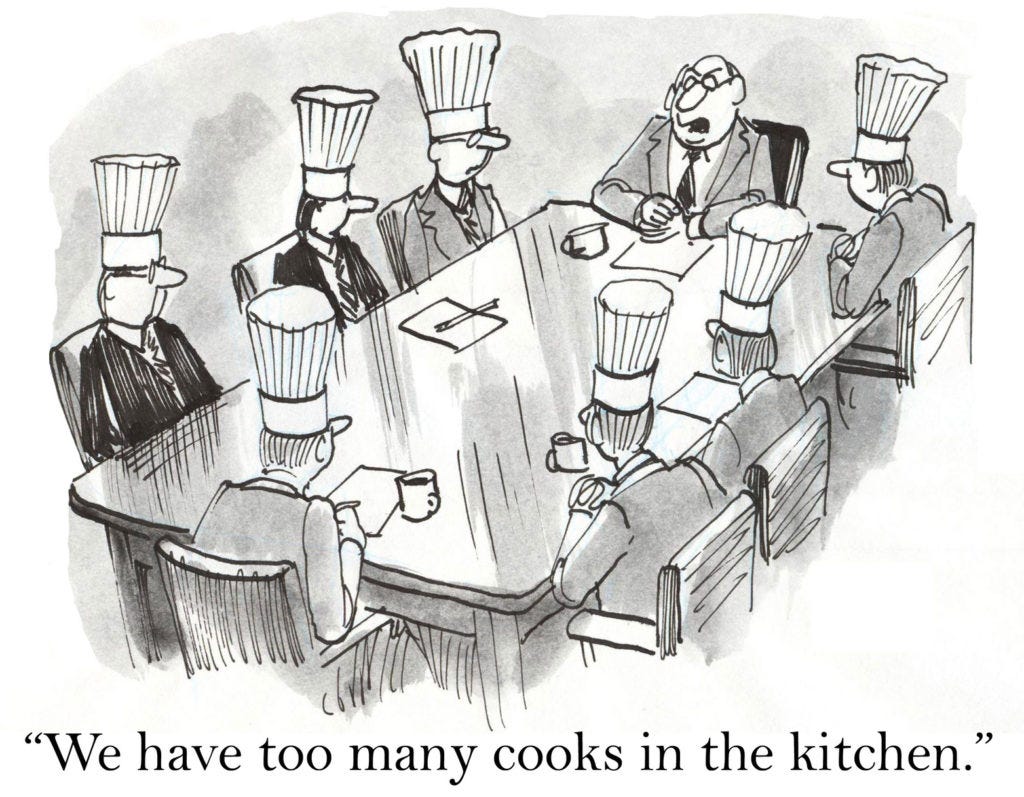Last week we published an article on “Pre-Wiring” – The Art of Getting Stakeholder Buy-In, and were blown away with the discussions that happened afterwards. As a reminder, pre-wiring is when you meet with stakeholders to get their buy-in and input before a decision. One question we thought worth diving in deeper was this:
What are the downsides to pre-wiring?
Let’s first start with a story.
Like what you’re reading? Subscribe below and we’ll send you 1 article like this each Thursday.
Story: Pre-Wiring at General Mills
Back when I worked at General Mills I was working on a product concept that became the Nature Valley Wafer Bar.

This bar filled a growing snack category customers were looking for – they wanted an indulgent treat, but wanted to justify it that it was “healthy”. After a grueling day of tasting about 50 product concepts, doing a couple of rounds of taste testing with consumers, and looking at lots of data, it was time to present it and make a decision to move forward.
The problem was there were about 20 stakeholders, each with opinions and personal preferences. I spent every day for about a month just sharing the findings with these people, with them oftentimes asking me to go talk to more employees! It literally took me a month just to talk to everyone. All for one meeting.
The time spent pre-wiring this group was far too much. But if I didn’t the project likely would not have moved forward. This is a perfect example of the dark side of pre-wiring.
Although the benefits are significant, there are four major downsides to pre-wiring:
(1) It takes too much time
(2) It dilutes and/or kills the idea
(3) It prioritizes coworkers over consumers
(4) It makes an idea vulnerable to deliberate sabotage
Downside #1: Pre-Wiring Takes Too Much Time
Pre-wiring focuses on building loyalty, buy-in, and input to an idea from the ground up. It sacrifices “time to market” speed in favor of building a firmer foundation for an idea so that execution is more likely to survive. The most obvious downside is that this takes far more time than simply going straight to the decision maker with an idea or proposal.
In my experience at General Mills, even with an effort to accelerate new products, the process to take something from concept to store takes two years. For tech companies like Tesla or Apple, that “time to market” for an idea/product can take over five years.
Time is our most valuable resource. If we spent a large portion of our time just getting our co-workers onboard with an idea, we could arguably be spending our precious hours much more effectively.
How to prevent the time risk: Pre-wiring conversations can be quick or held in groups. This will often speed up the process. Additionally I’ve often sent out written ideas and invited folks to respond (via Slack or email). If they don’t respond, I assume they’ve been informed and I proceed. The main goal here is to speed up input. (Note: This is less effective with major/complex ideas than with minor/simple ideas).
Downside #2: Pre-Wiring Can Dilute and/or Kill the Idea
When done well, pre-wiring builds a strong “support network” for an idea/proposal. The best case scenario is getting to the decision maker’s desk and having every head in the room nodding in approval and support (because they’ve all bought into the idea well in advance of the presentation).
The cost to this happy outcome? The risk of “too many cooks in the kitchen”.

When you circulate an idea as part of the pre-wiring process you want to invite input and innovation. But that also means you risk diluting the idea’s potency. The idea can get watered down after passing through too many hands. You can easily fall prey to the natural human desire to give everyone an equal voice.
In the worst case, you end up with something that doesn’t offend anyone, but doesn’t really make anyone happy or truly solve the problem. Sometimes the best ideas are ones that are dramatic and decisive. And that can mean rattling some cages.
How to prevent the dilution risk: This is the one I’m actually least worried about. Be as accommodating as you can without sacrificing the potency of the recommendation. Let them know upfront that you want their input, but can’t guarantee it will make it be part of the final version of the proposal. In general, folks just appreciate being heard, even if you can’t implement all of their suggestions. They will feel like they had a voice in the room. And that’s ultimately what matters most.
Downside #3: Pre-Wiring Prioritizes Coworkers Over Consumers
I teach a university course on Storytelling with Data, where the whole point of the class is to learn how to share data with teams and executives. Literally the class is about pre-wiring coworkers to accept your opinion!
In most business school programs there is only one course on consumer insights and a litany of classes on how to best fit into a corporate environment. Most decisions have internal tollgates where people sign off. One of the best CEOs I have worked with would only approve a product progressing through a process if it was validated with consumers. This led to amazing products where everyone was focused on the consumer.
How to prevent prioritizing coworkers: This is perhaps the hardest one to change, especially in large companies since processes are set. Take an honest look at your latest project and see how much of your time was spent with end consumers versus coworkers. If you’re not spending at least half of your time working with consumers you should re-evaluate your priorities. Pre-wiring coworkers only gets easier if you have consumers backing you up.
Downside #4: Pre-Wiring Makes an Idea Vulnerable to Deliberate Sabotage
This last pre-wiring risk is the least common of all, but it’s the most frustrating: having a good idea killed by someone who seeks to sabotage it once they learn that there’s a possibility the CEO/decision maker will hear about it and have that idea implanted.
This most often happens in low-trust / highly toxic work environments, where people will “kill the forest” to “save their tree” (for example, a sales leader torpedoes a new low-cost product that will be crucial for the company’s long term strategy, because it will lower the commissions of their team).
How to prevent the sabotage risk: This one is frankly hard to stop if someone is determined to be a bad actor. If that’s a legitimate risk in your business, you probably want to be up front with the decision maker before you even get started (for example: “I’m going to work on XYZ idea and present it to you within a few weeks. I know this will likely go against what so-and-so wants to happen. I’m going to work with them directly to get their input and see if we can find a good solution between us, but I wanted you to be aware as they may come to you with negative feedback and I think this idea is worth investigating before we kill it prematurely.”)
Our other advice: if this happens frequently when you pre-wire, you should probably look for a better work environment 🙂
Final Thoughts
Even though pre-wiring clearly has some downsides, we’re still firm believers that the pros far outweigh the cons.
Otherwise, the world would have never known the Wafer Bar in all its delicious glory!



1 thought on “The Downsides of “Pre-Wiring””
Thank you for your time and effort to have had these things together on this website. Mary and I very much loved your suggestions through your own articles over certain things. I know that you have a number of demands on your own schedule so the fact that you actually took as much time like you did to help people like us through this article is definitely highly liked.